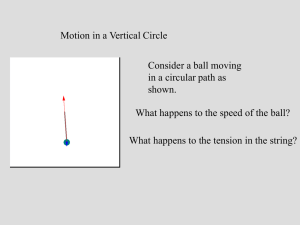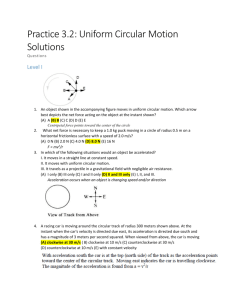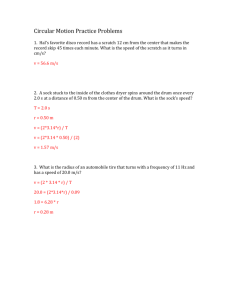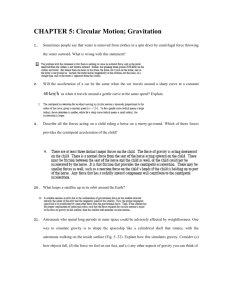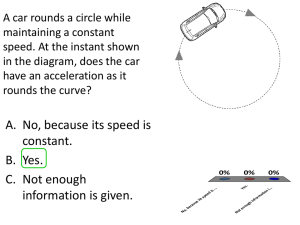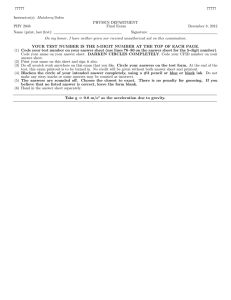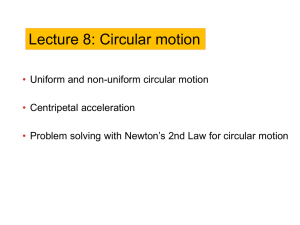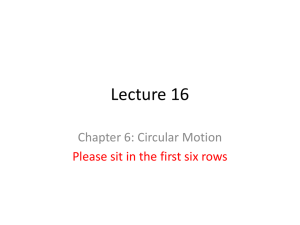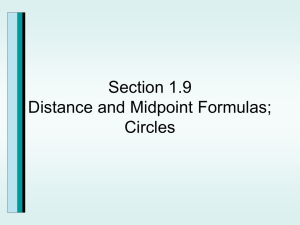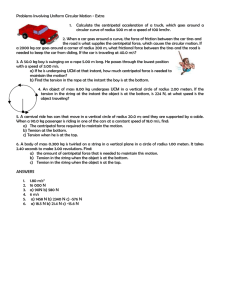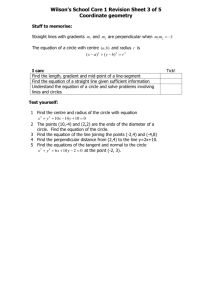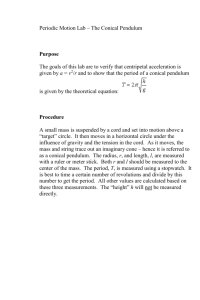Circular Motion
advertisement
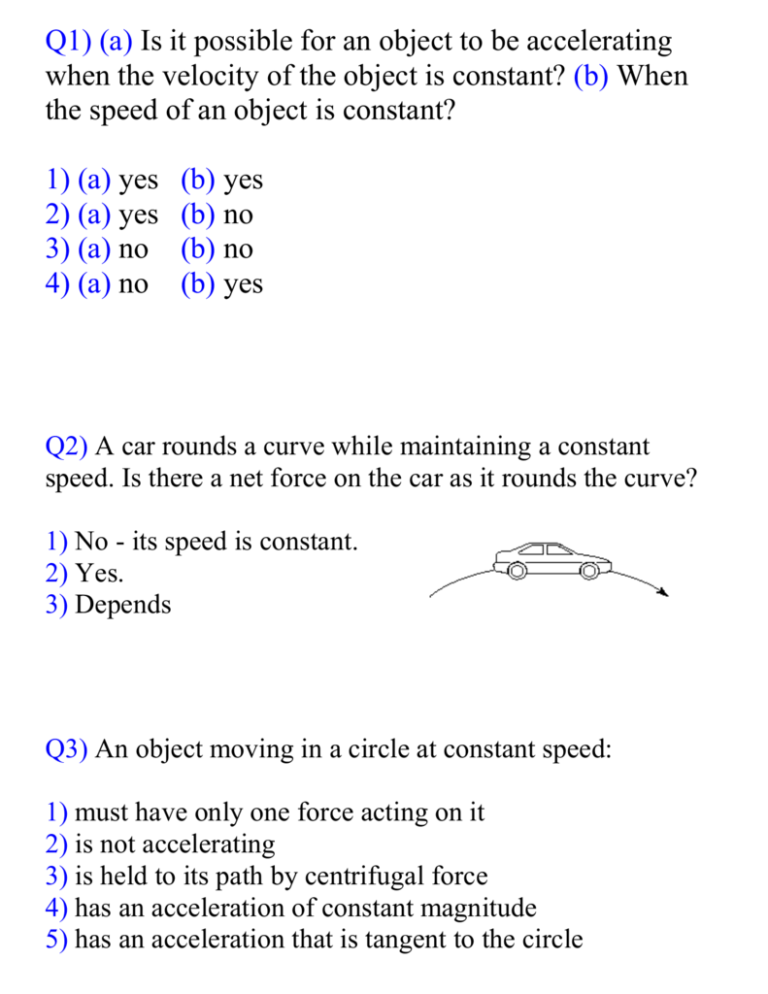
Q1) (a) Is it possible for an object to be accelerating when the velocity of the object is constant? (b) When the speed of an object is constant? 1) (a) yes 2) (a) yes 3) (a) no 4) (a) no (b) yes (b) no (b) no (b) yes Q2) A car rounds a curve while maintaining a constant speed. Is there a net force on the car as it rounds the curve? 1) No - its speed is constant. 2) Yes. 3) Depends Q3) An object moving in a circle at constant speed: 1) must have only one force acting on it 2) is not accelerating 3) is held to its path by centrifugal force 4) has an acceleration of constant magnitude 5) has an acceleration that is tangent to the circle Q4) A particle moves at constant speed in a circular path. The instantaneous velocity and instantaneous acceleration vectors are: 1) both tangent to the circular path 2) both perpendicular to the circular path 3) perpendicular to each other 4) opposite to each other 5) none of the above Q5) A ball is whirled on the end of a string in a horizontal circle of radius R at constant speed v. The centripetal acceleration of the ball can be increased by a factor of 4 by 1) keeping the speed fixed and increasing the radius by a factor of 4. 2) keeping the radius fixed and increasing the speed by a factor of 4. 3) keeping the radius fixed and increasing the period by a factor of 4. 4) keeping the radius fixed and decreasing the period by a factor of 4. 5) keeping the speed fixed and decreasing the radius by a factor of 4. Q6) A rock is whirled on the end of a string in a horizontal circle of radius R with a constant period T. If the radius of the circle is reduced to R/2, while the period remains T, what happens to the centripetal acceleration of the rock? 1) It remains the same. 2) It increases by a factor of 2. 3) It increases by a factor of 4. 4) It decreases by a factor of 2. 5) It decreases by a factor of 4. Q7) A car is traveling at a constant speed along the road ABCDE shown in the drawing. Sections AB and DE are straight. Rank the accelerations in each of the four sections according to magnitude, smallest first. 1) all tie 2) AB & DE tie, BC, CD 3) AB & DE tie, CD, BC 4) CD, BC, AB & DE tie 5) BC, CD, AB & DE tie Q8) A wheel of 0.50 m radius rotates at 15 rev/s. What is the acceleration at its outer rim in m/s2? 1) 2.2 x 103 2) 3.3 x 102 3) 4.4 x 103 4) 5.5 x 102 5) 6.6 x 103 Q9) A toy racing car moves with constant speed around the circle shown below. When it is at point A, its coordinates are x = 0, y = 3m and its velocity is (6m/s)i. When it is at point B its velocity and acceleration are: 1) (6 m/s)j and (12 m/s2)i, respectively 2) (6 m/s)i and (12 m/s2)i, respectively 3) (6 m/s)j and (12 m/s2)i, respectively 4) (6 m/s)i and (2 m/s2)j, respectively 5) (6 m/s)j and 0, respectively Q10) As you make a right-hand turn in your car, you are pushed against the door to your left. This is because 1) the centrifugal force pushed you to the left. 2) no force pushed you to the right. Q11) A particle moves along the circular path shown, with constant speed. Its velocity vector at two different times is shown. What is the direction of the acceleration when the particle is at point x? B x C A D E) zero Q12) The moon does not fall and hit the earth because 1) It generates a gravitational force = and opposite to the earth's pull. 2) The net force on it is zero. 3) It is beyond the main pull of the Earth's gravity. 4) It is being pulled by the sun and planets as well as by the earth. 5) none of the above. Q13) A rider in a "Barrel O’ Fun" finds herself stuck with her back to the wall. Which diagram correctly shows the forces acting on her? Pink Blue 1 2 Green 3 Purple Yellow 4 5 Q14) If the Rotor initially moves at the minimum required speed for the rider not to fall and then its speed is increased, do the following increase, decrease, or remain the same: (a) the magnitude of fs; (b) the magnitude of N? 1) (a) increase 2) (a) remain the same 3) (a) remain the same 4) (a) remain the same 5) none of the above (b) increase (b) remain the same (b) increase (b) decrease Q15) A mass is hanging from a rope and swinging around a circular path at constant speed. The situation is shown in the figure. Which of the pictures show the forces on the mass (neglect air resistance)? Support rope mass circular path T FC T mg mg FC mg 1) T 2) 3) Q16) In a game of tetherball, a ball is tied to a pole with a string. While the ball whirls around the pole, in what direction is the acceleration of the ball (at the moment shown?) A B C D (E/5: Some other direction, not shown.) Q17) A penny is placed on a rotating turntable. Where on the turntable does the penny require the largest centripetal force to remain in place? 1) at the edge of the turntable 2) at the center of the turntable 3) it is the same everywhere on the turntable Q18) A car of mass m, traveling at constant speed, rides over the top of a hill. The magnitude of the normal force N of the road on the car is. 1) greater than the weight of the car, N > mg. 2) equal to the weight, N = mg. 3) less than the weight, N < mg. Q19) A certain string breaks when it is under 400 N of tension. A boy uses this string to whirl a 10 kg stone in a horizontal circle of radius 10 m. The boy continuously increases the speed of the stone. At approximately what speed will the string break? 1) 10 m/s 2) 20 m/s 3) 80 m/s 4) 100 m/s 5) 400 m/s Q20) A 0.25-kg ball attached to a string is rotating in a horizontal circle of radius 0.5 m. If the ball revolves twice every second, what is the tension in the string? 1) 2 N 2) 5 N 3) 7 N 4) 10 N 5) 20 N Q21) In the figure below, suppose the car is on the verge of sliding when the radius of the circle is R. If we double the car's speed, what is the least radius that would now keep the car from sliding? 1) R/4 2) R/2 3) R 4) 2R 5) 4R Q22) A plane is flying in a vertical circle of radius 210 m. If the pilot's mass is 67 kg, what is the speed the plane must have in order for the pilot to experience a force of "2 G's" at the bottom of the circle? 1) 45 m/s 2) 2100 m/s 3) 21 m/s 4) 4.6 m/s
